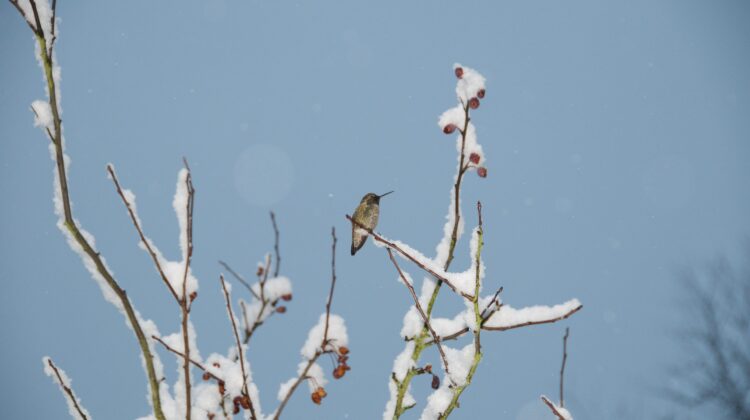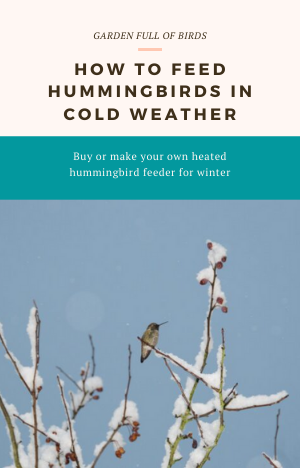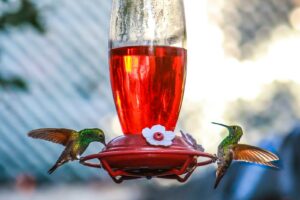
While we tend to think of hummingbirds as hot climate birds, there are several species that spend the whole year in colder climates. Hummingbirds are a bird that is in constant movement, and they need a large and continuous supply of sugary nectar to survive. This becomes very problematic when the weather is cold and there are no flowers around. Installing a heated hummingbird feeder or a homemade solution that keeps the feed from freezing will attract many hungry hummers to your garden even in the worst of winter!
If you have a hummingbird feeder in your garden you can do a lot to help them survive cold spells. Even the sugary syrup on the hummer feed freezes or becomes too thick to be drank by the birds. Keeping the nectar syrup from freezing is the most important aspect of feeding hummingbirds in winter. However, offering a warm and secluded place to feed will also help these tiny birds survive until the next Spring. Here are some steps you can take to keep hummingbirds in your garden even in winter!

Position And Protect The Feeder Correctly
The best way to offer hummingbirds a cozy refuge to eat in Winter is to place the feeder in a protected place. Whether this is a covered porch or a secluded nook under the roof, find somewhere they can hide from the wind and the snow and keep their body temperature. This alone won’t prevent the nectar from freezing but can go a long way to keep hummers in your garden during the beginning of the cold season.
Try to place the feeder in direct sunlight for as long as possible, but keep it away from the wind and elements. Exposure can lower the temperature enough for the nectar to freeze or become too thick. Cold weather will delay fermentation and make the nectar last longer, but it’s still advisable to replace it often so it remains fluid.
Add Snow Baffle Weather Domes
If your climate is prone to snow, protecting the feeder from snow and sleet must be a priority. Those are called snow baffles, or weather domes. Hummingbirds are very nimble flyers and will be able to get under a dome as long as there is enough space to fly in.
Unlike summer baffles (which are there to protect the hummers from excessive sun exposure), Snow baffles come in dark colors that will absorb the sunlight and keep the feeder inside significantly warmer than the outside.
Find a dome that is wider than the feeder so snow or sleet blowing sideways can’t get in. If snow gets in it may block the ports and then the birds won’t be able to access the nectar. Wind also makes cold temperatures feel even colder, so even if technically the nectar shouldn’t freeze due to the sugar content, wind can lower the temperature enough to freeze it and clog the ports.
Insulate The Feeder
For a cold spell or mild cold weather, a bit of insulation can be enough to keep a non heated hummingbird feeder from freezing. You can use fabric to insulate the main reservoir but it works even better when you use pipe insulation or even bubble wrap. It won’t look as pretty, but it can make all the difference between cold nectar and a frozen lump of ice.
Wrap the reservoir with pipe insulation or bubble wrap and make sure there is no hanging loose plastic ends that could cover the ports or flap into the delicate birds flightpath. You can use rubber bands to keep it in place, or you can fashion a sock cover instead for extra insulation.
In order to keep it in place, cut the toes of a warm sock and use the tube to wrap around the reservoir and the insulation. Wool is more insulating than synthetic fibers, but if it gets wet it will take ages to dry.
Keep in mind it will be more difficult to see the feed nectar levels if they are covered in insulation, so check often and refill as necessary.
Rotate The Feeders
Since hummingbirds feed during the day, you can also bring the feeders indoors overnight to prevent them from freezing. To help the birds survive a cold spell you should rotate several feeders, bringing them indoors to warm them. This can be time consuming but it will save the lives of many hummers, including those who are surprised by a cold wave before they start their migration.
However, if you are doing this keep in mind they are very early risers and they’ll need their breakfast at the crack of dawn. While this may require an alarm, putting the thawed feeders outdoors in time for sunrise will reward you with lots of very happy birds and an amazing opportunity for bird watching in your own garden.
Get A Heated Hummingbird Feeder For Winter
Some people keep several types of feeders and choose a heated feeder for the cold half of the year.
If you have a saucer style hummingbird feeder you can even acquire a dedicated mini-heater with a thermostat that will transform any feeder into a heated hummingbird feeder in winter. Since there are no insects in winter you won’t run the risk of attracting the wrong kind of critter with an open saucer feeder.
Alternatively, you can purchase a heated hummingbird feeder for winter with ports. They are usually made of glass with a little lamp to heat the nectar and come in a variety of different styles. In summer you can just disconnect it and use it as a regular hummer feeder minus the heating.
No products found.
You will need a secluded placement, under the eaves on a patio or maybe sheltered by a wall, and a weather insulated electrical plug and outlet. Do not risk your home or health by causing a fire or electrical hazard with a non-weatherproof electric point.
If you don’t have access to such an outlet, a battery operated heated hummingbird feeder is also a great option, though they tend to drain quite quick if the weather is very cold. It is often worth purchasing a second battery so you can always keep the feeder warm enough for the birds to drink.
Use Window Feeders
A good alternative to a heated hummingbird feeder is a window feeder. They are lovely all year around, as you can really get to see the birds drinking very close to you. In cold weather the warmth from the house will keep both the hummers and the nectar safe from freezing. As long as the weather is not very cold, and the house is not very well insulated, the birds will be able to feed.

DIY Heated Hummingbird Feeder Ideas
If the weather is very cold, insulation alone is most likely not going to keep the feeder working. So you will need to install a source of heat to maintain the temperature. This involves heat and electricity in some fashion or other, so be very careful not to create a fire hazard. Glass hummingbird feeders are the safest choice here, as plastic can melt and catch fire easily.
Here are some ideas:
Heat Tape Heated Hummingbird Feeder
Heat tape is often used by plumbers to keep pipes from freezing and that’s exactly what you want to achieve here.
No products found.
This kind of table is a non-adhesive tape which looks like a flat extension cord with a silicone coating. They have a thermostat to keep the temperature constant at above freezing and will require plugging into an electrical source.
To install it, wrap the plumber’s heating tape around the reservoir and use electrical tape to attach it. Only use this with glass feeders, and make sure you don’t overlap the tape to avoid causing a fire hazard. Be very careful as you will have a live heating element on the feeder next to water, so you could cause a short-circuit or a fire.
Work Lamp
Place a work light adjacent to the feeder, between 12-24″ away. This is what plumbers do when trying to slowly defrost a frozen pipe. A 125 Watt infra-red light bulb with clear glass casts the most natural light and still provides enough heat. Connect it to a timer to minimise the risk of fire.
Alternatively, place Christmas lights around the reservoir, but only do this with a glass feeder. Also, make sure you are using traditional lights, LED ones won’t produce any heat and are purely decorative.
As you can see, there are many ways to keep your hummingbirds fed during the winter season, and as the weather patterns become more unpredictable it may make a huge difference to the bird populations in many areas. Feeding hummingbirds in cold weather is a lovely way to help local populations and transient birds on their way to their wintering spots, and it doesn’t need to cost a lot of time or effort.
Can I use an extra feeder and line just the bottom of it and have the heater underneath for the hummingbirds to sit in to keep warm?
I’d say not many hummingbirds will take you on your kind offer, as they don’t necessarily want to sit still even on a heated place. They would probably appreciate the nectar more than the resting space 🙂